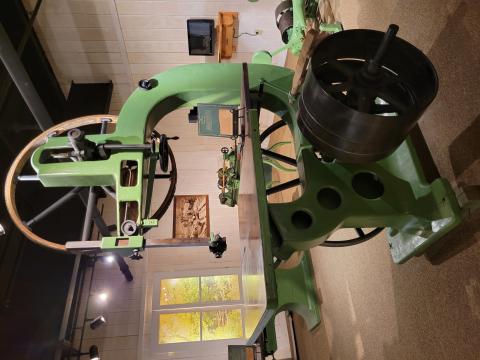This item is a bandsaw produced by the Frank H. Clement Company in Rochester, New York. The company produced a long line of woodworking and other industrial-type machinery during the late 1800s, although the precise manufacture date of this particular piece of equipment is unknown. This particular type of bandsaw was operated by a technician who used a lever to raise or lower the wheel on which the machine's band sat. This gave the technician a great deal of control over the types of cuts that needed to be made. The advantages of a bandsaw over other types of woodcutting instruments was that they could be used to make irregular or curved cuts for special pieces, whereas more standard machinery would be better suited to simple straight cuts. The wider application potential for bandsaws in woodcutting helped increase the volume of specialized material that could be produced by a single technician. This particular type of bandsaw also had the advantage of having a toothed blade, which increased the evenness of the cuts. This object can be used with the following standards: SS 4.25: Technological Change The introduction of the bandsaw was part of a larger change in the industrial landscape which saw the creation and implementation of more specialized machinery for manufacturing purposes. The introduction of such specialized machinery resulted in a drastic shift in the methods of mass-production of goods, particularly in fields such as the lumber and metalworking industries. These changes contributed to the wider impact of the Industrial Revolution on Iowa and the world. For any use other than instructional resources, please check with the organization that owns this item for any copyright restrictions.
2018.024.007 [Saw, Woodworking]
Legal Status
Copyright to this resource is held by the Sawmill Museum and has been provided here for educational purposes only, specifically for use in the Iowa Museum Association's "Teaching Iowa History" project. It may not be downloaded, reproduced or distributed in any format without written permission from the Rights Holder. For more information on U.S. and International copyright laws, consult an attorney.

